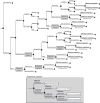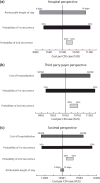The economic burden of Clostridium difficile
- PMID: 21668576
- PMCID: PMC3763211
- DOI: 10.1111/j.1469-0691.2011.03571.x
The economic burden of Clostridium difficile
Abstract
Although Clostridium difficile (C. difficile) is the leading cause of infectious diarrhoea in hospitalized patients, the economic burden of this major nosocomial pathogen for hospitals, third-party payers and society remains unclear. We developed an economic computer simulation model to determine the costs attributable to healthcare-acquired C. difficile infection (CDI) from the hospital, third-party payer and societal perspectives. Sensitivity analyses explored the effects of varying the cost of hospitalization, C. difficile-attributable length of stay, and the probability of initial and secondary recurrences. The median cost of a case ranged from $9179 to $11 456 from the hospital perspective, $8932 to $11 679 from the third-party payor perspective, and $13 310 to $16 464 from the societal perspective. Most of the costs incurred were accrued during a patient's primary CDI episode. Hospitals with an incidence of 4.1 CDI cases per 100 000 discharges would incur costs ≥$3.2 million (hospital perspective); an incidence of 10.5 would lead to costs ≥$30.6 million. Our model suggests that the annual US economic burden of CDI would be ≥$496 million (hospital perspective), ≥$547 million (third-party payer perspective) and ≥$796 million (societal perspective). Our results show that C. difficile infection is indeed costly, not only to third-party payers and the hospital, but to society as well. These results are consistent with current literature citing C. difficile as a costly disease.
© 2011 The Authors. Clinical Microbiology and Infection © 2011 European Society of Clinical Microbiology and Infectious Diseases.
Conflict of interest statement
The authors have no conflicts of interest to declare.
Figures


References
-
- Dubberke ER, Wertheimer AI. Review of current literature on the economic burden of Clostridium difficile infection. Infect Control Hosp Epidemiol. 2009;30:57–66. - PubMed
-
- Kelly CP, LaMont JT. Clostridium difficile – more difficult than ever. N Engl J Med. 2008;359:1932–1940. - PubMed
-
- Leffler DA, LaMont JT. Treatment of Clostridium difficile-associated disease. Gastroenterology. 2009;136:1899–1912. - PubMed
-
- Song X, Bartlett JG, Speck K, Naegeli A, Carroll KC, Perl TM. Rising economic impact of Clostridium difficile-associated diesease in adult hopsitalized patient population. Infect Control Hosp Epidemiol. 2008;29:823–828. - PubMed
-
- Ananthakrishnan AN, McGinley EL, Binion DG. Excess hospitalisation burden with Clostridium difficile in patients with inflammatory bowel disease. Gut. 2008;57:205–210. - PubMed
Publication types
MeSH terms
Grants and funding
LinkOut - more resources
Full Text Sources
Other Literature Sources

